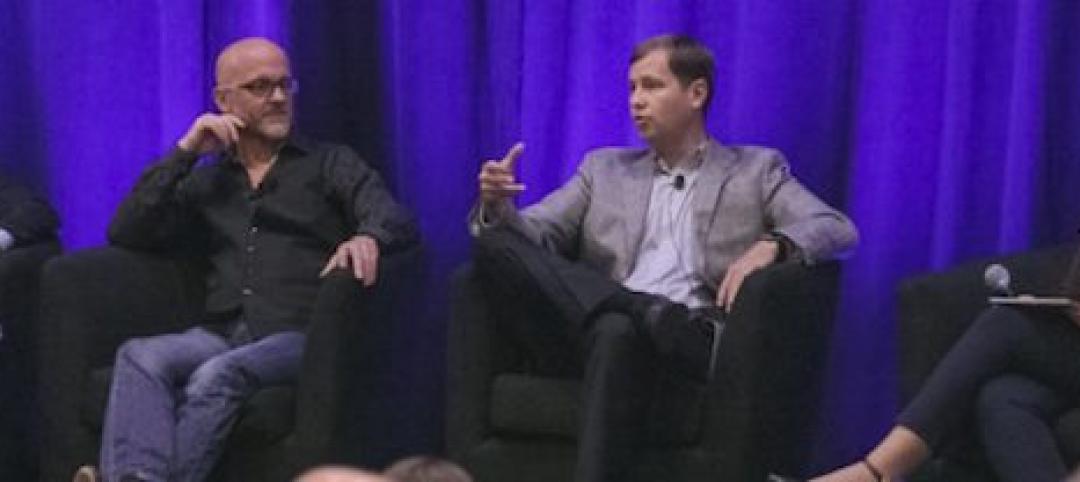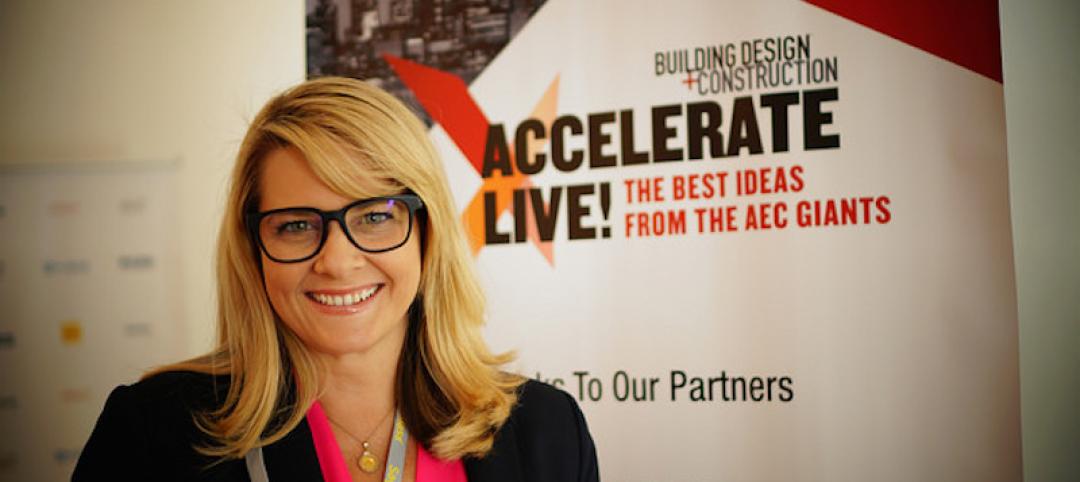Both of these facts being true may seem illogical at first, but everyone reading this knows exactly what I’m talking about. Problems vary in size and complexity, and the consequences can range from “mild annoyance” to “catastrophic work stoppage.” But one thing all problems have in common is that implementing the solution can expose inefficiencies, necessitate the use of new technological tools and entail real change. And if there’s anything tougher to deal with on the jobsite than a problem, it’s change.
But change we must. Whether we’re solving problems, rolling out new workflows, integrating new technologies, or improving processes and procedures, we have to find ways to move forward without taking two steps back in the process. So as an industry, how do we both implement change and preserve momentum? This is where the benefit of community and shared knowledge comes in.
I was fortunate enough to curate and moderate two panel discussions at AECX in downtown LA not too long ago. One discussion included AEC Hackathon co-founders Paul Doherty and Damon Hernandez, former DPR Innovation Team leader turned Innovation Evangelist and Adoption Strategist for SpectrumAEC Nathan Wood, BIM Manager Southern California Region at DPR Construction Josh DeStefano and Director of Mobile Mapping at Psomas, David Paul Johnson. We talked about the most common mistakes AEC professionals make when introducing new technologies and workflows to their teams. By following their advice, implementing solutions may actually become your team’s secret strength and unlock your organization’s unrealized potential.
Mistake #1: Never say never
Not even the smallest problem can be pushed off forever. And even the biggest, most intractable mess of a problem has a solution. Whether you’ve been waiting for the right day to talk about making a change, or pushing off tackling the overwhelming issues that are plaguing your project and impacting your profits, you can never afford to say never. Yes, taking action is risky. Addressing problems can easily create more problems. But failing to address them, or failing to consider every solution isn’t just risky, it’s suicidal. The AEC industry is changing at its fastest pace ever, and organizations that fail to get in the fast lane risk being passed by. The time for planning, for research, for asking questions, for exploring possibilities is now. If you wait until business dies down to address critical flaws in your organization, you do so at the risk of losing business as other more nimble organizations win the bids and break more ground year after year.
#2: Timing is everything
Even though change is the name of the game these days, every solution has its time and place. Successful implementation requires that changes are rolled out at a pace your team can absorb. Some problems can be directly addressed by a simple solution, while other problems require multi-faceted approaches that may involve entirely new technologies and procedures. And in both cases the “when” and “how” are just as important as the “what.” Rolling out a slew of even small changes in too short a timeframe can create a patchwork of solutions that are especially fatiguing. And using a phased-approach for implementing big changes allows for team leaders to assess the effects of change on a real-time basis, and provide the latitude necessary to customize the roll-out based on an organization's strengths and weaknesses.
A philosophy gaining traction in the industry is “just in time” training. Promoted largely by the Lean Construction Institute (LCI), the idea is to time training to align with specific project stages, so that users are better equipped to retain and implement lessons learned. This is not unlike other modular building trends.
#3: Get buy-in before implementation
Real change—the kind that removes obstacles, speeds timetables, saves money, and improves safety— cannot be simply mandated from above. Change that doesn’t include buy-in from your team may be adopted with sincere gusto at the outset, but risks being marginalized and abandoned as old habits and procedures creep back in. Instead of mandating change, begin by proving value. First work with your team to clearly and precisely define the problem and its consequences. This may take longer than you think, as even simple problems may impact other processes or project partners downstream. Once a problem has been clearly defined, a solution can be judged on its merits and organically adopted instead of simply being implemented. When a proposed solution is proven to effectively address a problem everyone agrees exists, team members are more likely to experience a greater sense of ownership regarding the solution and are more likely to provide the buy-in that delivers the most value from the solution.
#4: Set expectations
With everything on the jobsite seemingly moving faster than ever, clearly defining procedures, processes, problems and expectations is more important than ever. Not every problem has a single solution, and not every solution is the cure to all your problems. The important thing is to define both your problems and your solutions clearly so expectations can be properly set, and most importantly, so your problems can be addressed without creating new ones. Unfulfilled promises and unmet expectations are totally avoidable since we create them through our own actions or inactions. If we promise, we need to deliver; so make sure you can actually deliver before you promise. And if we fail to meet an expectation, then we clearly let an unrealistic expectation develop through our own inaction. These are both issues that can be addressed through clear communication and (most importantly) active listening. Understanding your problems is only half the struggle. Truly understanding the capabilities, hopes and fears of your team is what enables you to actually solve a problem, instead of just throwing money and activity at it.
#5: Repeat!
In the AEC industry, we’re all too familiar with project “moon shots.” A project team hits it out of the park, successes are logged, and innovation is achieved, but memorializing the lessons learned and raising the bar on the next project still eludes us. Change is not an activity, it is a state of being. An organization that is adaptable to change is an organization that learns as it grows. And organizational learning is the goal. A single experience without context or reflection isn’t much of anything. But refining an approach through repeated application is the very essence of learning. When we go through an exercise, we just go through the motions. There’s no feedback, no improvement. It’s one-and-done and then lost forever. But real change learns and adapts. The risk is real and failure can lurk behind every misstep. But through repeated application, our approach is refined and our solution is customized to fit the real problem. And if you judge the results of a complicated solution to a complicated problem after your first attempt—well, I hope you enjoyed the exercise. Do it again, and again and again, if you want to solidify the gains. It truly gets better every time.
More from Author
Sasha Reed | Dec 15, 2017
Future vs. current state of construction innovation: How will we make the leap?
Looking beyond today’s constraints to the possibility of what “could be” is a key characteristic of those defining and delivering innovation to design and building firms across the globe.
Sasha Reed | Sep 19, 2017
BIM vs VDC…how the US and the UK differ in approaching digital project delivery
In this four-part series, Bluebeam VP Sasha Reed sat down with industry experts to examine the need for defining and understanding digital workflows and data management throughout the design and construction project lifecycle.
Sasha Reed | Jul 19, 2017
Introducing StrXur by Bluebeam
Our goal is to present unique perspectives you may not be able to find anywhere else.
Sasha Reed | Jul 13, 2017
Defining the future by mastering the art of change
From my perspective, what separates organizations thriving in the digital revolution from those who are not boils down to one thing: leadership.
Sasha Reed | Mar 15, 2017
Incentivizing change: Show me the money
Who is succeeding, and on what terms? And what will it take for everyone to experience the benefits of that success?
Sasha Reed | Oct 4, 2016
The talent shortage: Will the training the AEC industry desperately needs arrive in time?
As the construction industry bounces back from the Great Recession, an entirely new class of tech-savvy construction professionals has been created, and the supply of these highly skilled, tech-proficient pros has been quickly exhausted.
Sasha Reed | Jul 11, 2016
Construction Disruption at AECX: Technology, hackathons and the promise of change in LA
The lead up to AECX featured a discussion providing insight into the current state of the AEC technological revolution by exploring opportunities, challenges and choices AEC pros face.
Sasha Reed | Jun 9, 2016
With all these sharks in the water… (No Predictions Here...Part 2)
Rather than fighting to control the proliferation of apps, perhaps we should be training our eyes to look for signs of long-term viability among all the fins in the water
Sasha Reed | Dec 17, 2015
How is the Value of VDC for Design Management Translating Outside the US?
Sascha Vesterlund, a VDC Specialist, Design Processer with MT Højgaard, and Nathan Wood, Innovation at DPR Construction, shared their perspectives on VDC















